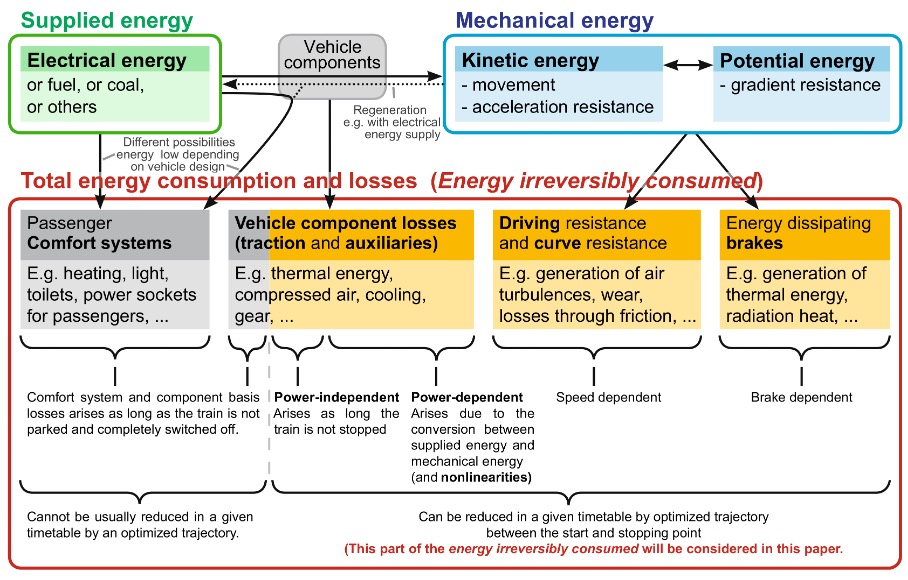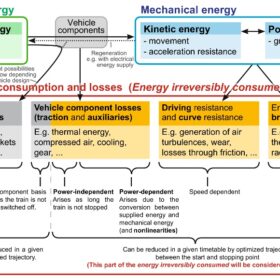
Energy modelling is extensive. Different detailed modelling approaches can lead to significant simulation deviations. Detailed modelling leads to additional energy savings.
Reducing energy consumption is an increasingly important topic in society and the railway system. The railway system already has a high energy efficiency compared to private mobility; nevertheless, it must also contribute to energy saving. Energy-efficient train control (EETC) is one solution that refers to mathematically computing when to accelerate, which cruising speed to hold, how long one should coast over a suitable space, and when to brake.
EETC and other energy-saving approaches in literature and industry greatly simplify a lot of nonlinear effects, such that they mostly ignore the losses due to energy conversion in traction components and auxiliaries. In some cases, the comparison in the literature is difficult because the models used are often not classified. To fill this gap, we explained and described the energy flow in vehicles. We classified the energy flow into increasingly detailed levels to enable standardized simulations. By using these levels, we compared the impact.
Outcomes of this Research
- Different detailed descriptions of the vehicle energy flow might cause evaluations for the same trajectory to differ by as much as 50%. That means simplified modelling can strongly underestimate or overestimate energy consumption. This strongly impacts the electrical system’s dimensioning, energy savings estimation and comparison of results.
- Detailed modelling levels prove the existence of an energy-efficient minimum speed. That means that below this speed, energy consumption increases again. Considering the energy-efficient minimum speed helps to avoid driving at too slow, inefficient speeds.
- Detailed modelling proves that Energy-efficient train control EETC consists of more than the four well-known modes: maximum acceleration, cruising, coasting and maximum braking. By simulation, the optimal trajectory with for EETC highly detailed level 3 results in two additional modes: reduced acceleration and reduced deceleration. Simulation with level 3, which considers these two modes, increases the energy saving.
 Michael Nold received the Dipl.-Ing. degree in mechanical engineering from the Karlsruhe Institute of Technology in 2014. He is currently pursuing a PhD with the Chair of Transport Systems, ETH Zurich. From 2014 to 2018, he worked as a Project Manager and an Engineer with Rhaetian Railway in the rolling stock division and was responsible for the system areas of responsibility: developments, calculations and measurement technology.
Michael Nold received the Dipl.-Ing. degree in mechanical engineering from the Karlsruhe Institute of Technology in 2014. He is currently pursuing a PhD with the Chair of Transport Systems, ETH Zurich. From 2014 to 2018, he worked as a Project Manager and an Engineer with Rhaetian Railway in the rolling stock division and was responsible for the system areas of responsibility: developments, calculations and measurement technology.
 Francesco Corman holds the chair of Transport Systems at the Institute of Transport Planning and Systems, ETH Zurich. He has a PhD in Transport Sciences from TUDelft, the Netherlands, further academic experience at KU Leuven, and practical experience as data science consultant at IBM. His main research interests are in the application of quantitative methods and operations research to transport systems, especially on the operational perspective, public transport, railways and logistics.
Francesco Corman holds the chair of Transport Systems at the Institute of Transport Planning and Systems, ETH Zurich. He has a PhD in Transport Sciences from TUDelft, the Netherlands, further academic experience at KU Leuven, and practical experience as data science consultant at IBM. His main research interests are in the application of quantitative methods and operations research to transport systems, especially on the operational perspective, public transport, railways and logistics.
